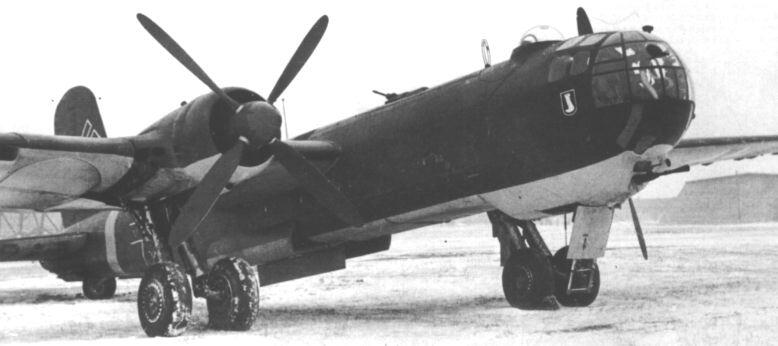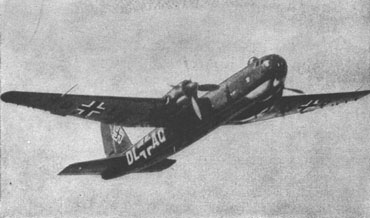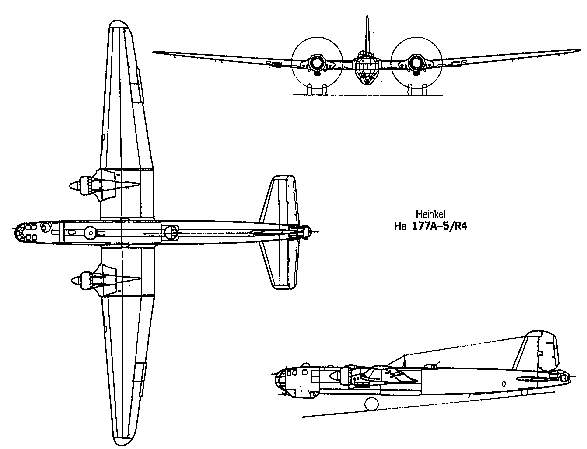|
Heinkel He-177 "Greif" (Griffin)

Perhaps no other aircraft of the German
Luftwaffe was so potentially useful, but so troublesome as the Heinkel
He-177 Greif. The Greif was detested by its crews, and by its mechanics.
It is a fine example of the unrealized possibilities of the German Air
Arm in the Second World War.
 |
The He177 only made it to production through dogged courage and
perseverance, and those two factors were the only thing that allowed
it to reach large production numbers. In defense of the aircraft
however, it could be said that all its troubles originated from
a (absolutely asinine) 1938 requirement for a proposed heavy bomber/anti-shipping
aircraft, that should also be capable of dive-bombing! So, the main
problem of the He-177 was created: In an effort to reduce drag,
the engineers decided that they would use coupled engines. (basically
four engines, stuck together into two nacelles) These coupled engines
would enter record books as being the most fire-prone engines in
normal cruising flight. Out of the eight prototypes, six crashed.
And of the 35 pre-production A-0s, (built for the most part by Arado
Handelsgesellschaft, Warnemunde) a large number had to be written
off due to take-off swings or in-flight fires. |
| Arado built 130 A-1s, followed by 170 Heinkel built
A-3s, and 826 A-5s, which had repositioned engines and a longer
fuselage. About 700 Greifs served on the Eastern Front, many of
these having 50mm and 75mm guns for tank-busting duties. A few even
(nervously) bombed England in 400mph shallow dives, without any
proper aiming for their bombs. The aircraft proved so bothersome
that Goering had to forbid Heinkel to pester him any more with plans
to use four separate engines! But Heinkel secretly flew the He277
with four 1-750hp DB 603A at Vienna, as the first of a major production
programme. The almost completly redesigned He274 was a high-altitude
bomber developed at the Farman factory at Suresnes, with four 1,850hp
engines, a 145ft wing and twin fins. After the liberation, it was
readied for flight, and flown at Orleans-Bricy. |
|
Perhaps the scariest fact about the He177 was the fact that one
was secretely being readied in Czechoslovakia to carry the planned
German Atomic bomb. It is quite possible that, if it weren't for
a few brave Norwegian saboteurs, Adolf Hitler would have had a
prepared Atomic bomb towards the war's end. I have no further
information on that special He177, and I would like anyone with
any to please send it to me.
Charles Bain
|
 |

Technical Data
Origin: Ernst Heinkel AG, also built by Arado Flugzeugwerke.
Type: He177, six seat heavy-bomber and missle carrier
Engines: Two 2,950hp Daimler-Benz DB 610A-1/B-1, each comprising
two inverted-vee-12 liquid-cooled engines geared to one propellor.
Dimensions: Span 103ft 1 3/4 in (31.44m); length 72ft 2in (22m);
height 21ft (6.4m)
Weights: Empty 37,038lb (16,800kg); loaded (A-5) 68,343lb (31,000kg)
Performance: Maximum speed (at 41,000lb) 295mph (472 km/h); initial
climb 853ft (260m)/min; service ceiling 26,500ft (7080m); range with
FX or Hs293 missles (no bombs) about 3,107 miles (5000km)
Armament: (A-5/R-2) one 7.92mm MG 81J manually aimed in nose,
one MG131 in forward dorsal turret, one MG 131 in rear dorsal turret,
one MG 151 manually aimed in the tail and two MG 81 or one MG 131 manually
aimed at rear of gondola; maximum internal bombload 13,200lb (6000kg),
seldom carried. External load: two Hs293 guided missiles, FX 1400 guided
bombs, mines or torpedoes (more if internal bay blanked off and racks
added below it.)
Users: Germany (Luftwaffe)
|


